At some point, many of us have experienced the post-lunch sleepy hour, struggling to stay alert mid-afternoon, and reaching for the water bottle to rehydrate a tired body.
But what about those people who suffer from “excessive daytime somnolence,” aka sleepiness that lasts throughout the day?
It’s a recognised medical condition that is normally diagnosed by a doctor after a full-day hospital procedure, undergoing what is called the Multiple Wakefulness Test (MWT).
Now, researchers from the University of South Australia have identified a new, brain-based measure of sleepiness that may provide a diagnosis in just two minutes.
Electrodes attached to the scalp in the form of an electroencephalogram (EEG) measure the electrical activity of the brain and this activity can determine the length of time it takes an individual to fall asleep.
In a separate, recent paper published in Brain Research, lead researcher, UniSA neuroscientist Dr Alex Chatburn, says that using new EEG markers linked to biological processes could predict whether someone is safe enough to drive, operate machinery, or even have the mental capacity to sit an exam.
“Sleepiness is a critical biological signal that indicates the body’s need for sleep, yet measuring this state in humans remains elusive,” Dr Chatburn says.
“While EEG technology has long been used to study brain activity during sleep, traditional markers face significant limitations and don’t tell the whole story. They don’t reflect the underlying biological processes, whereas our method tracks neuronal excitability, corresponding with the brain’s sleep-wake processes.”
Dr Chatburn says the research has wide-ranging implications.
“A better understanding of sleepiness could not only advance scientific knowledge, but also provide practical benefits for managing sleep disorders like insomnia, sleep apnoea or other disorders where individuals experience disrupted sleep but do not feel sleepy.
“These findings could also inform workplace safety, where detecting and managing sleepiness could prevent accidents in industries that demand high levels of attention.”
The team are presenting their findings at the Sleep DownUnder 2024 conference in the Gold Coast this week.

